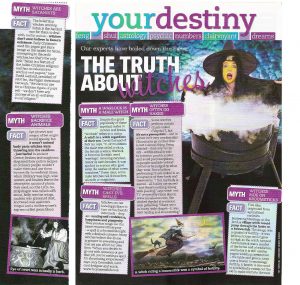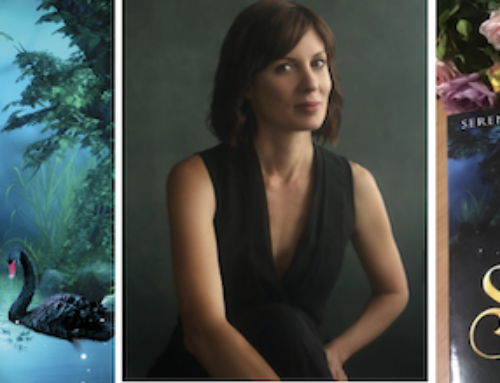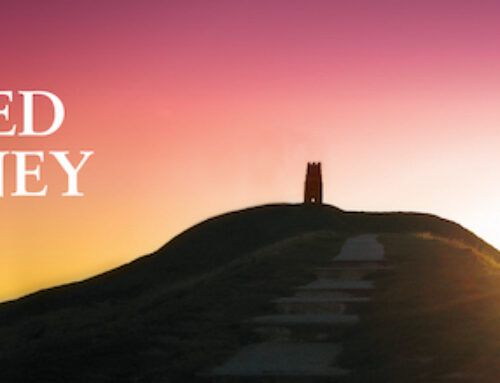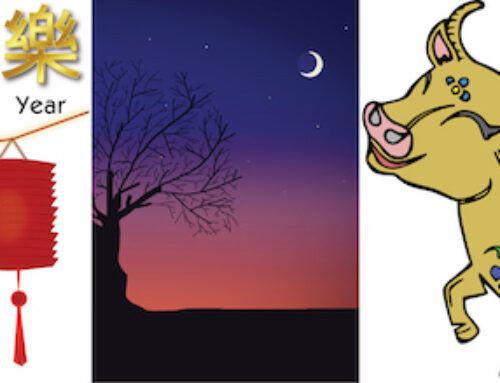 The Truth About Witches
The Truth About Witches
Woman’s Day – national weekly magazine
Witches honour nature as sacred, recognise the masculine and feminine side of god and do rituals and spells to empower, help and heal. It is the fastest growing religion in Australia – but still the most misunderstood. By Serene Conneeley.
Myth: You can tell a witch by her green skin and pointy nose
False. Historically a witch was the wise woman of the community, the person to go to for healing, advice and matchmaking. But through political and religious attacks, that image has been twisted into an evil old hag with a green warty face (thanks Hollywood!). But as pretty blonde magazine covergirl Fiona proves, witches can’t be easily identified.
Stacey DeMarco, attractive corporate businesswoman and author of There’s A Witch In The Boardroom, wears suits and carries a briefcase. At home she wears jeans and a shirt. At the personal development workshops she conducts she’s regularly asked: “I wonder when the witch is getting here?”
“Being a witch is not about what you wear or how you look, it’s your values and the way you live your life. One of my missions in life is to bring back honour, respect and the truth to the word witch. I want people to be able to say they are a witch and for it to have the correct connotation. Not: ‘She must be a witch because she dresses like a goth,’” Stacey says.
Adds David: “Pagans come from all walks of life: police officers, nurses, doctors, teachers, lawyers etc. You never know, your next door neighbour may be one! Paganism does not discriminate according to colour, race, creed or sexual preference, as all are equal in the eyes of the god and goddess.”
Myth: Witches are Satanists
False. The belief that witches worship Satan is the hardest for witches to deal with, and completely untrue! They don’t even believe in his existence, although early Christians did use the image of the pagan god Pan as the model for Satan, hence the confusion.
“Satan is a feature of the Judeo/Christian religions, and has no relevance to witches and pagans,” says David Garland, president of Australia’s Pagan Awareness Network. “We have no use for a Christian figure of pure evil – we don’t have any concept of an all-evil deity in our religion.”
Adds Fiona Horne, celebrity witch and TV star, “In my early investigations into witchcraft I read some sensationalist Satanic books parading as guides to witchcraft, but it was nothing to do with the religion I felt emerging from within me – it was too close to Christianity for me.”
Witches do believe in positive and negative aspects, but they are to do with nature and people, not their deities. They also take responsibility for their actions, and would never blame the devil for causing them to do bad things.
Myth: There are white witches and black witches
False. It has been coined as a media term, and is sometimes embraced because the term witch is still perceived to mean evil, but there is no distinction.
“I don’t like the term ‘white witch’ because it implies there are black witches, and that is encouraging medieval misconceptions about the Craft,” says Fiona Horne. “Witchcraft is about embracing polarities – the light and the dark – not denying or suppressing them. We respect the darker emotions of anger, pain and fear as much as the lighter ones of love and empathy. But light and dark are not the same as good and evil. Real witches know it is a far greater show of power to help and heal than it is to harm. A witch who is actually adept enough to cast an effective hex – a harmful spell or curse – is also smart enough to know not to do it. And she wouldn’t – it’s just not dignified!”
Myth: Witches sacrifice animals
False. Eye of newt and tongue of bat might sound spooky, but it wasn’t animal body parts the witches were throwing into the cauldron, just herbs. There were two reasons for the strange names. In ancient Greece the healers/magicians disguised their potion recipes so ordinary people couldn’t poison themselves, thus bat’s wings was actually holly, calf’s snout was just snapdragon, sparrow’s tongue was a herb called knotweed, graveyard dust referred to mullein, blood of a goose was a mulberry tree’s sap, tears of a baboon was dill juice and hairs of a baboon was dill seed. And in medieval times, when illiteracy was the norm, the wise women and healers – witches – who used herbs for healing, learned the descriptive names of the plants they used, not their Latin name. Naming a plant for its resemblance to part of an animal was common, giving us names like lamb’s tongue, coltsfoot, cranesbill, eye of newt, dragon’s blood, liverwort, wolfsbane, birds tongue, devil’s eyes, bloodroot, green snake, catnip, cowslip, foxglove, hounds tongue, horsetail, lambs tongue, unicorn root and wormwood, amongst other slightly creepy names!
Myth: Witches cast spells
True. But they’re not stirring up potions to turn their ex-boyfriend into a toad – they’re creating self-confidence, happiness and prosperity. A spell is just a focused thought, and differs little from prayer in other religions. But while the Christian interpretation is a petition to an external deity to create the change, many witches believe the divine is present in everything, including ourselves. A spell is just another word for prayer, and ritual and ritual tools simply make the prayer more effective.
“Spells are a clever natural way to activate your own psychological disposition to go after what you activate in your own psyche,” says Lucy Cavendish, tarot card creator and witch. ”It’s putting together a series of ingredients in such a way that it activates that potential within yourself and focuses you. When you decide you’re going to go out with that person, or get that job, you’re casting a spell. It means sending out. You cast a fishing line – you send it out and bring something back. It’s about being empowered, knowing you can change things.”
Witches practise magic for similar purposes that Christians pray. Magic is a way of understanding and influencing the world, and is used both for external purposes (getting a job, blessing a house etc.) and internal purposes (gaining a better understanding of yourself).
Myth: Witches perform blood sacrifices
False. Witches believe in the sanctity of all life and the cycle of life, death and rebirth. Most believe that animals are part of the same natural cycle of life as humans are. If they eat meat they offer their thanks to the animal who died for them. The nature of sacrifice is to give up something of one’s own in order to gain something more important. When they take something from nature, like a branch to make a wand, they leave an offering in return, such as a prayer of gratitude, a crystal or a libation. When a spell helps them achieve something they will give back, perhaps by donating money to a charity or planting a tree. Witches have often been associated with animal familiars who they work with – and treat very well – and many are involved in environmental or animal rights groups.
Myth: A pentacle, or pentagram, is a symbol for evil
False. The pentacle, a five pointed star surrounded by a circle, is popular in jewellery, clothes and tattoos, and has come to identify people with pagan beliefs. Pythagoras used it as a symbol of health, and his followers wore them in order to recognise one another. In medieval times, some Christian knights used the pentagram as their symbol. It is used by witches as a symbol of protection and in ritual. “The five points represents the elements of earth, air, fire and water, and the fifth is ether, being the spirit,” David Garland says. “The pentacle is an amulet and a symbol for protection. And in some traditions it is used inverted to show differing degrees of initiation, not an affiliation with Satan.”
Myth: There is a definition of witchcraft
False. Witchcraft is a religion of personal responsibility and growth, a spiritual path that involves the individual discovering their own beliefs and moral code. Some witches believe in the god and goddess, some in a goddess only, some in a whole pantheon of deities, and some believe there is nothing outside of themselves. Some embrace the Christian god alongside other deities. Some cast spells and some don’t. It is a personal belief system that can involve worship, meditation, ritual, healing, herbcraft, the raising of energy, spellcasting, divination or fortune telling, clairvoyance and other psychic abilities. Most hold the earth sacred and the cycles and seasons of nature to be important and include male and female aspects of divinity. No one person speaks for all witches, and a strong basis of witchcraft is respect for other people’s opinions and beliefs, including those of other religions. The basic belief is: “And it harm none, do what you will.”
Myth: A warlock is a male witch
False. Despite its popularity in movies and books, warlock actually meant traitor. “A witch is a witch regardless of their sex,” David Garland says. “In the old traditions the male was called a Wicca, and the female was a Wicce. Warlock is from a Scottish word, “worloga”, meaning ‘deceiver’, ’traitor’, or ‘oath breaker’, and was applied to anyone who during the Inquisition or Burning Times who gave away the names of other coven members.”
Some male witches today refer to themselves as wizards or magicians – like all things within witchcraft and paganism it is a personal decision
Myth: Witches have ritual orgies
False. Witches have no rules which prohibit homosexuality, nudity or pre-marital sex, but they feel that the physical act of love is to be approached with great respect and responsibility. Sex as the generative force in nature is seen by most pagans as something utterly sacred.
“Witches have a very healthy attitude towards our bodies and sex. We consider the body sacred and not something that can be debased or handed over to another person or the devil,” says Fiona Horne. “The union between a heterosexual couple is symbolically represented at every coven gathering. It celebrates the idea that a male and a female can create life – and that’s sacred. Ninety-nine per cent of all sex magic in ritual is expressed symbolically. I certainly don’t think that’s any more bizarre than the ritual of communion, where you eat the body of Christ and drink his blood. That’s cannibalism!
“Love and sex and sexuality, expressing a love of sex and a love of life are all considered divine. I no longer suffer the guilt I did as a Catholic schoolgirl, being led to believe I had the choice of being Madonna or whore.”
Myth: Witches ride on broomsticks
False. This came about because in old times, when people relied more on agriculture and the village witch bestowed blessings of the land, the practise of jumping through the fields on a broomstick was common. The now common image of a witch sitting on a broomstick was seen as a symbol of fertility, and it was believed that the crop would grow as high as the witch could jump.
A broomstick was also a symbol of the home, and by extension of midwives, and today it is still used in pagan wedding ceremonies (hand fastings) – the bride and groom jump over the broom to encourage fertility. And aside from the practical use of sweeping the floor, it is used to symbolically sweep out the old and make room for the new.
“I have a broom which I use for both purposes – magical and practical,” Lucy Cavendish says. “Each time I use it to sweep up, I see the energy of my house as refreshed and renewed. My broom is especially beloved for the service it provides, and I appreciate its magical value as a space cleanser. It also reminds me that every home needs a little magic: what good is there in simply removing the superficial layers of dirt if we don’t go beneath and renew who we are when we clean? The broom is everyone’s reminder to regularly refresh and cleanse our spirits – to sweep up our old attitudes, emotions and situations that are keeping us bogged down and stuck in the past.”
Myth: Witches are always skyclad (naked)
False. While some witches perform some rituals naked, it is not a prerequisite, and not as common as Hollywood makes out. And for those that do, it’s not about sex. Being skyclad – clad only by the sky – within ritual is believed to enhance psychic power. It is also like removing a mask – it gives a sense of equality as clothes can cause judgments to be made about the wearer, so being naked is said to avoid preconceptions. Some see it as a challenge to their ingrained restrictive upbringing, and that being able to do ritual naked is an acceptance of their body and themselves.
“I feel that my body is sacred – that all bodies are sacred – and there’s nothing wrong with it, so I tend to be uninhibited,” Fiona Horne says. “I worked skyclad at a women-only gathering, which involved a ritual where we were all naked. It was incredibly liberating. There were so many body types and shapes: bodies that hadn’t had children; bodies that had had five kids; bodies that had had five kids and 13 grandchildren.
“We’re brought up on a diet of these two-dimensional air-brushed images, so it was fantastic being surrounded by real women. It was very healing and empowering. But being skyclad in the middle of winter isn’t very comfortable,” she laughs.







Get Social